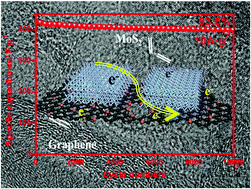A few-layered MoS2 nanosheets/nitrogen-doped graphene 3D aerogel as a high performance and long-term stability supercapacitor electrode†
Abstract
Typical advanced transition-metal dichalcogenides, in particular molybdenum disulfide (MoS2), have recently attracted intense interest owing to their unique properties and tremendous application prospects in electrochemical energy storage. However, the limited re-stacking of atomic layers by van der Waals forces restrictedly affects their electrochemical characteristics. Herein, the construction of three-dimensional (3D) architectures via 2D mono- or few-layered MoS2 nanosheets and nitrogen-doped graphene aerogels has been employed to obtain and retain conductive networks; as a result, large surface areas and high electrical conductivities were achieved. When used as a supercapacitor electrode material, this hybrid aerogel exhibits an excellent specific capacitance of 532 F g−1 at a current density of 1 A g−1 and a superior cycling stability of 93.6% capacitance retention after 10 000 cycles at 10 A g−1, which is significantly higher than those of MoS2 nanosheets and nitrogen-doped graphene aerogels alone. Therefore, it is believed that these 3D hybrid aerogels of MoS2 nanosheets/nitrogen-doped graphene (3D MoS2/N-GAs) have great potential to become promising candidates for supercapacitor electrode materials.



 Please wait while we load your content...
Please wait while we load your content...